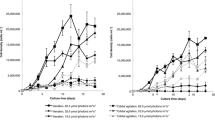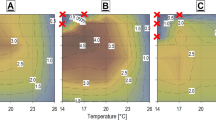Abstract
The natural pigment fucoxanthin has attracted global attention because of its superior antioxidant properties. The haptophyte marine microalgae Pavlova spp. are assumed to be promising industrial fucoxanthin producers as their lack of a cell wall could facilitate the commercialization of cultured cells as a whole food. This study screened promising Pavlova strains with high fucoxanthin content to develop an outdoor cultivation method for fucoxanthin production. Initial laboratory investigations of P. pinguis NBRC 102807, P. lutheri NBRC 102808, and Pavlova sp. OPMS 30543 identified OPMS 30543 as having the highest fucoxanthin content. The culture conditions were optimized for OPMS 30543. Compared with f/2 and Walne’s media, the use of Daigo’s IMK medium led to the highest biomass production and highest fucoxanthin accumulation. The presence of seawater elements in Daigo’s IMK medium was necessary for the growth of OPMS 30543. OPMS 30543 was then cultured outdoors using acrylic pipe photobioreactors, a plastic bag, an open tank, and a raceway pond. Acrylic pipe photobioreactors with small diameters enabled the highest biomass production. Using an acrylic pipe photobioreactor with 60-mm diameter, a fucoxanthin productivity of 4.88 mg/L/day was achieved in outdoor cultivation. Thus, this study demonstrated the usefulness of Pavlova sp. OPMS 30543 for fucoxanthin production in outdoor cultivation.






Similar content being viewed by others
Data Availability
The data supporting the findings of this study are available within this article or from the corresponding author upon reasonable request. Pavlova pinguis NBRC 102807 and Pavlova lutheri NBRC 102808 can be obtained from the National Biological Resource Center (NBRC).
References
Afolayan AF, Bolton JJ, Lategan CA, Smith PJ, Beukes DR (2008) Fucoxanthin, tetraprenylated toluquinone and toluhydroquinone metabolites from Sargassum heterophyllum inhibit the in vitro growth of the malaria parasite Plasmodium falciparum. Z Naturforsch C J Biosci 63:848–852
Alkhamis Y, Qin JG (2013) Cultivation of Isochrysis galbana in phototrophic, heterotrophic, and mixotrophic conditions. Biomed Res Int 2013:983465
Brown MR, Jeffrey SW, Volkman JK, Dunstan GA (1997) Nutritional properties of microalgae for mariculture. Aquaculture 151:315–331
Dang TT, Bowyer MC, Van Altena IA, Scarlett CJ (2017) Comparison of chemical profile and antioxidant properties of the brown algae. Int J Food Sci Technol 53:174–181
Dembitsky VM, Maoka T (2007) Allenic and cumulenic lipids. Prog Lipid Res 46:328–375
Fariman GA, Shastan SJ, Zahedi MM (2016) Seasonal variation of total lipid, fatty acids, fucoxanthin content, and antioxidant properties of two tropical brown algae (Nizamuddinia zanardinii and Cystoseira indica) from Iran. J Appl Phycol 28:1323–1331
Fernandes T, Martel A, Cordeiro N (2020) Exploring Pavlova pinguis chemical diversity: a potentially novel source of high value compounds. Sci Rep 10:339
Gammone MA, d’Orazio N (2015) Anti-obesity activity of the marine carotenoid fucoxanthin. Mar Drugs 13:2196–2214
Gao F, Teles Cabanelas Itd I, Wijffels RH, Barbosa MJ (2020) Process optimization of fucoxanthin production with Tisochrysis lutea. Bioresour Technol 315:123894
Gayen K, Bhowmick TK, Maity SK (2019) Sustainable Downstream Processing of Microalgae for Industrial Application. CRC Press, Boca Raton
Gómez-Loredo A, Benavides J, Rito-Palomares M (2016) Growth kinetics and fucoxanthin production of Phaeodactylum tricornutum and Isochrysis galbana cultures at different light and agitation conditions. J Appl Phycol 28:849–860
Green JC (1980) The fine structure of Pavlova pinguis Green and a preliminary survey of the order Pavlovales (Prymnesiophyceae). Br Phycol J 15:151–191
Guihéneuf F, Stengel DB (2013) LC-PUFA-enriched oil production by microalgae: accumulation of lipid and triacylglycerols containing n-3 LC-PUFA is triggered by nitrogen limitation and inorganic carbon availability in the marine haptophyte Pavlova lutheri. Mar Drugs 11:4246–4266
Guihéneuf F, Mimouni V, Tremblin G, Ulmann L (2015) Light intensity regulates LC-PUFA incorporation into lipids of Pavlova lutheri and the final desaturase and elongase activities involved in their biosynthesis. J Agric Food Chem 63:1261–1267
Guillard RRL, Ryther JH (1962) Studies of marine planktonic diatoms: I. Cyclotella nana Hustedt, and Detonula confervacea (Cleve) Gran. Can J Microbiol 8:229–239
Hiller RG, Larkum AWD, Wrench PM (1988) Chlorophyll proteins of the prymnesiophyte Pavlova lutherii (Droop) comb. nov.: identification of the major light-harvesting complex. Biochimica et Biophysica Acta - Bioenergetics 932:223–231
Hosokawa M, Wanezaki S, Miyauchi K, Kurihara H, Kohno H, Kawabata J, Odashima S, Takahashi K (1999) Apoptosis-inducing effect of fucoxanthin on human leukemia cell line HL-60. Food Sci Technol Res 5:243–246
Ikeda K, Kitamura A, Machida H, Watanabe M, Negishi H, Hiraoka J, Nakano T (2003) Effect of Undaria pinnatifida (Wakame) on the development of cerebrovascular diseases in stroke-prone spontaneously hypertensive rats. Clin Exp Pharmacol Physiol 30:44–48
Kawee-ai A, Kuntiya A, Kim SM (2013) Anticholinesterase and antioxidant activities of fucoxanthin purified from the microalga Phaeodactylum tricornutum. Nat Prod Commun 8:1381–1386
Kim SM, Kang SW, Kwon ON, Chung D, Pan CH (2012) Fucoxanthin as a major carotenoid in Isochrysis aff. galbana: Characterization of extraction for commercial application. J Korean Soc Appl Biol Chem 55:477–483
Kotake-Nara E, Kushiro M, Zhang H, Sugawara T, Miyashita K, Nagao A (2001) Carotenoids affect proliferation of human prostate cancer cells. J Nutr 131:3303–3306
Lananan F, Jusoh A, Ali N, Lam SS, Endut A (2013) Effect of Conway medium and f/2 medium on the growth of six genera of South China Sea marine microalgae. Bioresour Technol 141:75–82
Lu X, Sun H, Zhao W, Cheng KW, Chen F, Liu B (2018) A hetero-photoautotrophic two-stage cultivation process for production of fucoxanthin by the marine diatom Nitzschia laevis. Mar Drugs 16:219
Maeda H, Fukuda S, Izumi H, Saga N (2018) Anti-oxidant and fucoxanthin contents of brown alga Ishimozuku (Sphaerotrichia divaricata) from the West Coast of Aomori Japan. Mar Drugs 16:255
Maeda H, Hosokawa M, Sashima T, Miyashita K (2007) Dietary combination of fucoxanthin and fish oil attenuates the weight gain of white adipose tissue and decreases blood glucose in obese/diabetic KK-Ay mice. J Agric Food Chem 55:7701–7706
Marella TK, Tiwari A (2020) Marine diatom Thalassiosira weissflogii based biorefinery for co-production of eicosapentaenoic acid and fucoxanthin. Bioresour Technol 307:123245
McClure DD, Luiz A, Gerber B, Barton GW, Kavanagh JM (2018) An investigation into the effect of culture conditions on fucoxanthin production using the marine microalgae Phaeodactylum tricornutum. Algal Res 29:41–48
Meireles LA, Guedes C, Malcata FX (2003) Increase of the yields of eicosapentaenoic and docosahexaenoic acids by the microalga Pavlova lutheri following random mutagenesis. Biotechnol Bioeng 81:50–55
Milke LM, Bricelj VM, Parrish CC (2008) Biochemical characterization and nutritional value of three Pavlova spp. in unialgal and mixed diets with Chaetoceros muelleri for postlarval sea scallops Placopecten magellanicus. Aquaculture 276:130–142
Ou L, Cai Y, Jin W, Wang Z, Lu S (2018) Understanding the nitrogen uptake and assimilation of the Chinese strain of Aureococcus anophagefferens (Pelagophyceae). Algal Res 34:182–190
Peng J, Yuan JP, Wu CF, Wang JH (2011) Fucoxanthin, a marine carotenoid present in brown seaweeds and diatoms: metabolism and bioactivities relevant to human health. Mar Drugs 9:1806–1828
Petrushkina M, Gusev E, Sorokin B, Zotko N, Mamaeva A, Filimonova A, Kulikovskiy M, Maltsev Y, Yampolsky I, Guglya E, Vinokurov V, Namsaraev Z, Kuzmin D (2017) Fucoxanthin production by heterokont microalgae. Algal Res 24:387–393
Shiratori K, Ohgami K, Ilieva I, Jin XH, Koyama Y, Miyashita K, Yoshida K, Kase S, Ohno S (2005) Effects of fucoxanthin on lipopolysaccharide-induced inflammation in vitro and in vivo. Exp Eye Res 81:422–428
Sivagnanam SP, Yin S, Choi JH, Park YB, Woo HC, Chun BS (2015) Biological properties of fucoxanthin in oil recovered from two brown seaweeds using supercritical CO2 extraction. Mar Drugs 13:3422–3442
Sugawara T, Matsubara K, Akagi R, Mori M, Hirata T (2006) Antiangiogenic activity of brown algae fucoxanthin and its deacetylated product, fucoxanthinol. J Agric Food Chem 54:9805–9810
Sun Z, Wang X, LiuJ, (2019) Screening of Isochrysis strains for simultaneous production of docosahexaenoic acid and fucoxanthin. Algal Res 41:101545
Susanto E, Fahmi AS, Abe M, Hosokawa M, Miyashita K (2016) Lipids, fatty acids, and fucoxanthin content from temperate and tropical brown seaweeds. Aquat Procedia 7:66–75
Tokushima H, Inoue-Kashino N, Nakazato Y, Masuda A, Ifuku K, Kashino Y (2016) Advantageous characteristics of the diatom Chaetoceros gracilis as a sustainable biofuel producer. Biotechnol Biofuels 9:235
Walne PR (1970) Studies on the food value of nineteen genera of algae to juvenile bivalves of the genera Ostrea, Crassostrea, Mercenaria, and Mytilis. Fish Invest 26:1–62
Wang S, Verma SK, Said IH, Thomsen L, Ullrich MS, Kuhnert N (2018) Changes in the fucoxanthin production and protein profiles in Cylindrotheca closterium in response to blue light-emitting diode light. Microb Cell Fact 17:110
Xia S, Gao B, Fu J, Xiong J, Zhang C (2018) Production of fucoxanthin, chrysolaminarin, and eicosapentaenoic acid by Odontella aurita under different nitrogen supply regimes. J Biosci Bioeng 126:723–729
Xia S, Wang K, Wan L, Li A, Hu Q, Zhang C (2013) Production, characterization, and antioxidant activity of fucoxanthin from the marine diatom Odontella aurita. Mar Drugs 11:2667–2681
Xiao X, Si X, Yuan Z, Xu X, Li G (2012) Isolation of fucoxanthin from edible brown algae by microwave-assisted extraction coupled with high-speed countercurrent chromatography. J Sep Sci 35:2313–2317
Yang R, Wei D (2020) Improving fucoxanthin production in mixotrophic culture of marine diatom Phaeodactylum tricornutum by LED light shift and nitrogen supplementation. Front Bioeng Biotechnol 8:820
Acknowledgements
The authors thank Dr. Takeshi Fujiwara, Dr. Takafumi Watanabe, and Ms. Yuko Koizumi for their technical assistance. We would like to thank NBRC for supplying Pavlova pinguis NBRC 102807 and Pavlova lutheri NBRC 102808.
Author information
Authors and Affiliations
Contributions
A. Kanamoto designed the study, conducted the experiments, and drafted the manuscript. Y. K., E. Y., T. H., and A. Kondo commented on the study, helped interpret results, and revised the manuscript. All authors approved the final version of the manuscript.
Corresponding author
Ethics declarations
Competing Interests
The authors declare that they have no competing interests.
Additional information
Publisher's Note
Springer Nature remains neutral with regard to jurisdictional claims in published maps and institutional affiliations.
A. Kanamoto was a CEO of OP Bio Factory at the time this study was conducted. A. Kanamoto participated in the experiments as a representative of OP Bio Factory. The corresponding author has full access to all the data in the study and is completely responsible for the data and its accuracy.
Rights and permissions
About this article
Cite this article
Kanamoto, A., Kato, Y., Yoshida, E. et al. Development of a Method for Fucoxanthin Production Using the Haptophyte Marine Microalga Pavlova sp. OPMS 30543. Mar Biotechnol 23, 331–341 (2021). https://doi.org/10.1007/s10126-021-10028-5
Received:
Accepted:
Published:
Issue Date:
DOI: https://doi.org/10.1007/s10126-021-10028-5




